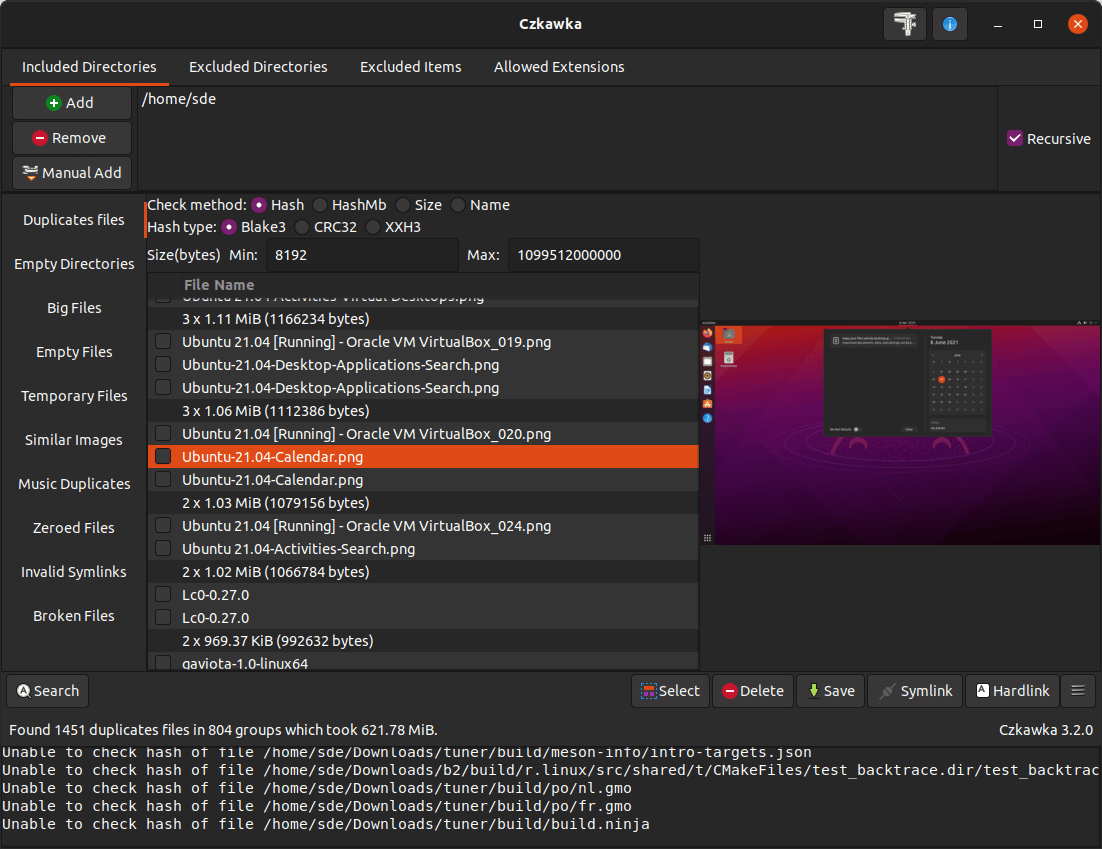Last Updated on May 28, 2022
In Operation
Czkawka offers two separate frontends consisting of a GTK graphical interface and a command-line interface. We spent most of the time testing the graphical interface.
Both interfaces share the same core module.
Here’s an image of the graphical interface in operation.

The menu bar at the top of the interface lets us define directories to include and exclude. By default, only your home directory is defined as an included directory, but it’s easy to add more directories. Excluded directories are /proc, /dev, /sys, /run, and /snap which can also be amended. The next menu entry lets us exclude specific item such as */.git/*. And we can also define the allowed extensions for macros, images, video, music, and text.
As the image shows, the software offers various functions. For each function we can select and/or delete entries, as well as saving the results to a file. The available functions are:
- Duplicates – Finds duplicates based on file name, size, hash, hash of just first 1 MB of a file. Available hash types are: Blake3, CRC32, and XXH3.
- Empty Directories – these are found using an advanced algorithm.
- Big Files – Finds the provided number of the biggest files in given location. By default this shows the size, file name and path of the 50 biggest files, but you can change this number.
- Empty Files – Looks for empty files across the drive.
- Temporary Files – Finds temporary files.
- Similar Images – Finds images which are not exactly the same (different resolution, watermarks). There’s a slider which lets you set the level of similarity from very high to minimal. And the image preview facility is particularly welcome. The program uses the hamming distance algorithm.
- Music Duplicates – Searches for music with the same artist, album etc.
- Zeroed Files – Finds files which are filled with zeros (usually corrupted).
- Invalid Symbolic Links – Shows symbolic links which point to non-existent files/directories.
- Broken Files – Finds files with an invalid extension or that are corrupted.
The bottom panel shows error messages detailing which directories cannot be opened.
Pages in this article:
Page 1 – Introduction / Installation
Page 2 – In Operation
Page 3 – Summary
Complete list of articles in this series:
| Essential System Tools | |
|---|---|
| Alacritty | Innovative, hardware-accelerated terminal emulator |
| BleachBit | System cleaning software. Quick and easy way to service your computer |
| bottom | Graphical process/system monitor for the terminal |
| btop++ | Monitor usage and stats for CPU, memory, disks, network and processes |
| catfish | Versatile file searching software |
| Clonezilla | Partition and disk cloning software |
| CPU-X | System profiler with both a GUI and text-based |
| Czkawka | Find duplicate files, big files, empty files, similar images, and much more |
| ddrescue | Data recovery tool, retrieving data from failing drives as safely as possible |
| dust | More intuitive version of du written in Rust |
| f3 | Detect and fix counterfeit flash storage |
| Fail2ban | Ban hosts that cause multiple authentication errors |
| fdupes | Find or delete duplicate files |
| Firejail | Restrict the running environment of untrusted applications |
| Glances | Cross-platform system monitoring tool written in Python |
| GParted | Resize, copy, and move partitions without data |
| GreenWithEnvy | NVIDIA graphics card utility |
| gtop | System monitoring dashboard |
| gWakeOnLAN | Turn machines on through Wake On LAN |
| hyperfine | Command-line benchmarking tool |
| inxi | Command-line system information tool that's a time-saver for everyone |
| journalctl | Query and display messages from the journal |
| kmon | Manage Linux kernel modules with this text-based tool |
| Krusader | Advanced, twin-panel (commander-style) file manager |
| Neofetch | System information tool written in Bash |
| Nmap | Network security tool that builds a "map" of the network |
| nmon | Systems administrator, tuner, and benchmark tool |
| nnn | Portable terminal file manager that's amazingly frugal |
| pet | Simple command-line snippet manager |
| Pingnoo | Graphical representation for traceroute and ping output |
| ps_mem | Accurate reporting of software's memory consumption |
| SMC | Multi-featured system monitor written in Python |
| Timeshift | Reliable system restore tool |
| QDirStat | Qt-based directory statistics |
| QJournalctl | Graphical User Interface for systemd’s journalctl |
| TLP | Must-have tool for anyone running Linux on a notebook |
| Unison | Console and graphical file synchronization software |
| VeraCrypt | Strong disk encryption software |
| Ventoy | Create bootable USB drive for ISO, WIM, IMG, VHD(x), EFI files |
| WTF | Personal information dashboard for your terminal |
